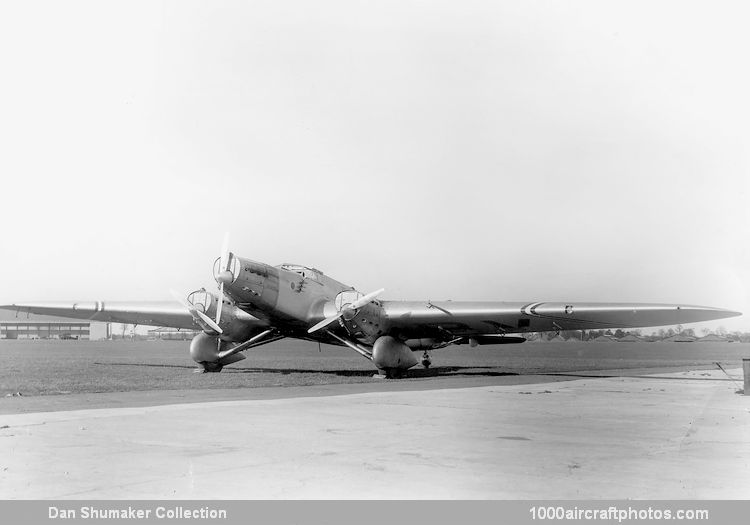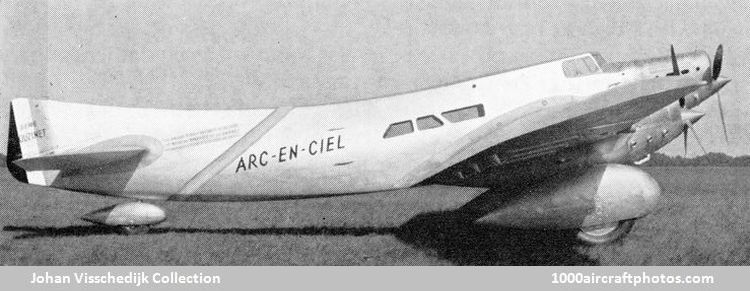07/31/2019. Remarks by
Johan Visschedijk: "Société des Avions René Couzinet in 1928 completed a rather curious three-engine monoplane for an attempt on the world distance record. This was the tubby Couzinet 10-01 designed by René Couzinet himself. Named Arc-en-Ciel (Rainbow), the aircraft was destroyed during a test flight on August 8, 1928, and a second was destroyed by fire, but Couzinet continued to develop a series of aircraft of unusual appearance. One of these was the Couzinet 70, which also bore the name Arc-en-Ciel. It was designed for the transatlantic section of Aéropostale's service between France and South America.
The Couzinet 70 was a low-wing cantilever monoplane with very thick section wing built up of two box spars and a series of box ribs with ply covering. The fuselage was a ply-covered wooden structure, and it was the unusual form of the fuselage which gave the Couzinet monoplanes their distinctive appearance. Forward, the fuselage was rectangular with rounded corners, but aft of the wing the top surface was tapered and swept up to form the fin. The rear of the fuselage formed a vertical knife edge to which the unbalanced rudder was attached. The upper or leading edge of the fin and the underside of the fuselage formed two parallel curving lines.
Three 650 hp Hispano-Suiza 12Nb twelve-cylinder liquid-cooled V-engines with frontal radiators and three-blade metal airscrews gave the aircraft a very heavy appearance. The landing gear consisted of two main units with the wheels faired by enormous spats, which in length almost equaled the chord of the wing. The tail wheel was enclosed in a slender spat. The tail plane, like the rest of the tail unit, was of wood, and originally was a cantilever structure.
(Couzinet 70) (
Johan Visschedijk Collection)
The crew comprised pilot, engineer, navigator and wireless operator. The enclosed cockpit was just forward of the leading edge, and further aft was a mail and freight compartment, and this had three quite small windows in each side. The Arc-en-Ciel bore its name along the fuselage sides, and the registration, F-AMBV, appeared only on the wing. ln January 1933 an Aéropostale crew headed by Jean Mermoz flew the Arc-en-Ciel to South America, making the actual ocean crossing from Saint Louis, Senegal to Natal, Brazil on January 16 in 14 hr 27 min.
After returning from this flight the Arc-en-Ciel underwent major modification and emerged as the Couzinet 71 (c/n 01), still with the same name and registration but operated by Air France, the successor to Aéropostale, although owned by the French Government.
In the rebuilding the fuselage was considerably lengthened, with the cockpit being placed further aft, the wing was given a very large fillet to fair it into the fuselage, and the tail plane was strut-braced and given vertical surfaces above and below it at about mid-span. The tail wheel was no longer enclosed in a fairing, and the cabin windows were altered in shape. The registration was added to the fuselage, and above the cabin windows were the words France-Amérique du Sud in capital letters. The same engines were retained, but two-blade metal airscrews replaced the former three-blade units.
In its modified form the Arc-en-Ciel began regular operation of Air France's South Atlantic mail services. These were at low frequency, and the first crossing from Saint-Louis to Natal was made on May 28, 1934, again with Mermoz in command. From July 24 that year the ocean service was operated monthly, with the Arc-en-Ciel and the Latécoère 300 flying boat Croix du Sud sharing the work. By the year's end the Arc-en-Ciel had made eight ocean crossings.
Subsequently, the Arc-en-Ciel underwent further modification when it was given cleaner-shaped engine cowlings, the radiators were repositioned beneath the rear of each engine, and the wheel spats replaced by fairings behind the wheels. The ultimate fate of the Arc-en-Ciel is not known."

